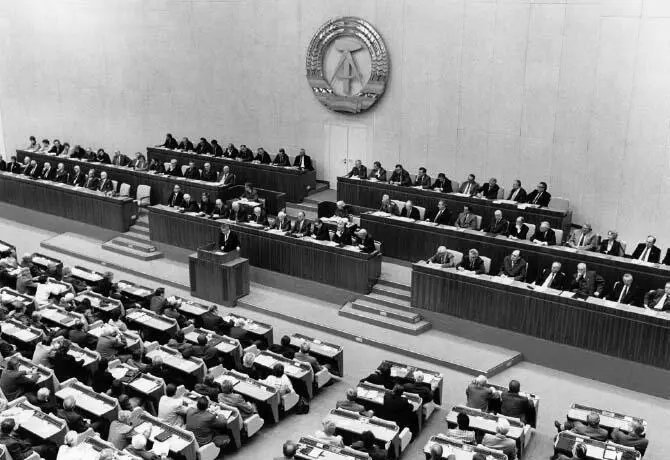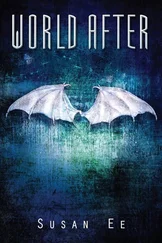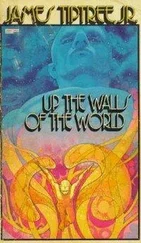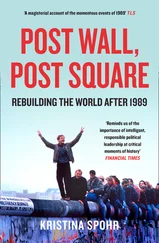It was a huge victory for the peaceful demonstrators and an epic defeat for the regime. ‘ Die Lage ist so beschissen, wie sie noch nie in der SED war ’ (‘The situation is so shitty, like it never was in the SED’), summed up one Politburo member on 17 October. [31]Next day Honecker resigned – officially on health grounds – and Krenz took over as party boss. [32]But that did not improve the public mood: the people interpreted the power transfer as the result of their pressure from below rather than as the outcome of party machinations and manoeuvrings going on ever since Honecker was taken seriously ill during the Warsaw Pact meeting in Bucharest in July. [33]

Egon Krenz at the Volkskammer as the New Party Secretary of the SED in East Berlin
Krenz promised the Party Central Committee on 18 October that he would initiate a ‘turn’ ( Wende ). He committed himself to open ‘dialogue’ with the opposition on two conditions: first, ‘to continue building up socialism in the GDR … without giving up any of our common achievements’ and second, to preserve East Germany as a ‘sovereign state’. As a result, Krenz’s Wende amounted to little more than a rhetorical tweak of the party’s standard dogma. And, in similar vein, the personnel changes he made among the leadership were largely cosmetic. There was, in short, little genuine ‘renewal’ in the offing: clearly Wende did not mean Umbruch (rupture and radical change). [34]
Not only did Krenz’s accession to power leave more reformist elements in the SED frustrated; worse, he personally appeared clueless in judging the true nature of the public mood. After his election to the post of SED general secretary, he asked the Protestant church leaders when ‘those demonstrations finally would come to end’. After all, continued Krenz obtusely, ‘one can’t spend every day on the streets’. [35]Little did he know.
In any case, Krenz was not a credible leader. Rumours were rife about his health and his alcohol problems. And ‘long-tooth’ Krenz, as he was nicknamed – a party hack for more than thirty years – had no plausibility as a ‘reformer’. So, rather than stabilising SED rule, his takeover actually served to fuel popular displeasure with the party and accelerated the erosion of its monopoly on power. What’s more, when the Krenz regime renounced the open use of force, that token concession only emboldened the masses to demand ever more fundamental change. They now felt they were pushing at an open door: ‘street power’ was shaking ‘the tower’. [36]
After the fall of Honecker on 18 October, anti-government protest – in the form of peace prayers, mass demonstrations and public discussions – spread right across the country. In the process various currents of criticism flowed together into a surging tide. Long-time dissidents from the churches; writers and intellectuals from the alternative left; critics of the SED from within the party; and the mass public spilling out onto the streets: all these fused in what might be called an independent public sphere. They spoke in unison for people’s sovereignty. Discontent was now open. The long spell of silence had been broken.
On 23 October in Leipzig, 300,000 participated in the Monday march around the ring road. In Schwerin on the Baltic, the ‘reliable forces’ who were meant to come out for the regime ended up in large swathes joining the parallel demo by Neues Forum. Next day the protests returned to East Berlin, whose squares had remained quiet since the brutal crackdown of 7 and 8 October. Overall, there were 145 anti-government events in the GDR in the last week of the month, and a further 210 in the first week of November. Not only were these protests growing, the demands were becoming both more diverse and also more pointed:
Die führende Rolle dem Volk (‘The leading role to the people’, 16 October)
Egon, leit Reformen ein, sonst wirst Du der nächste sein! (‘Egon, introduce reforms, or else you’ll be next!’, 23 October)
Visafrei bis Hawaii! (‘Visa-free travel to Hawaii!’, 23 October)
Demokratie statt Machtmonopol der SED (‘Democracy instead of the SED’s monopoly on power’, 30 October)
Conversely, the SED leadership appeared lost for words. Increasingly unable to win the argument, the Krenz Politburo hid behind traditional orthodoxy. [37]In particular, the party was totally unwilling to give up its constitutionally entrenched ‘leading role’ ( Führungsanspruch ) – which was the principal demand of all those who wanted liberalisation and democratisation. [38]To make matters worse, while seeking to reinstate its authority, the regime showed itself bewildered and helpless in the face of the GDR’s deteriorating economic situation. Discussions in the Politburo revolved around how to get consumers more tyres, more children’s anoraks, more furniture, cheaper Walkmen and how to mass-produce PCs and 1 MB chips – not the structural flaws of the economy. [39]
Only on 31 October were the stark realities finally laid bare in an official report to the Politburo by the chief planner, Gerhard Schürer, on the economic state of the GDR. The country’s productivity was 40% lower than that of the Federal Republic. The system of state planning had proved totally unfit for purpose. And the GDR was close to national insolvency. Indebtedness to the West had risen from 2 billion Valutamarks in 1970 to 49 billion in 1989. [fn1]Merely halting further indebtedness would entail a lowering of the East Germans’ living standards by 25–30% in order to service the existing debt. And any default on debt repayments would risk opening the country to an IMF diktat for a market economy under conditions of acute austerity. For the SED, this was ideologically untenable. In May, Krenz had declared that economic policy and social policy were an entwined unit, and had to be continued as such because this was the essence of socialism in the GDR. So the regime was trapped in a vicious circle: socialism depended on the Plan, and the survival of the planned economy required external credits on a scale that now made East Germany totally dependent on the capitalist West, especially the FRG. [40]
Straight after this fateful Politburo meeting, Krenz flew to Moscow for his first visit to the Kremlin as the GDR’s secretary general. There on 1 November he admitted the economic home truths to Gorbachev himself. The Soviet leader was unsympathetic. He coldly informed Krenz that the USSR had been aware of East Berlin’s predicament all along; that was why he had kept pressing Honecker for reforms. Even so, when Gorbachev heard the precise figures – Krenz said the GDR needed $4.5 billion in credits simply to pay off the interest on its debts – the Soviet leader was, for a moment, speechless – a rare occurrence. The Kremlin was in no position to help, so Gorbachev could only advise Krenz to tell his people the truth. And, for a country that had already haemorrhaged over 200,000 alienated citizens since the start of 1989, this was not a happy prospect. [41]
Afterwards, Krenz tried to put the best face on things in a seventy-minute meeting with the foreign press, presenting himself as an ‘intimate friend’ of Gorbachev and no hardliner. But the media were not convinced. When Krenz talked policy, he sounded just like Honecker, his political mentor, and he flatly rejected any talk of reunification with West Germany or the removal of the Berlin Wall. ‘This question is not on the table,’ Krenz insisted. ‘There is nothing to reunify because socialism and capitalism have never stood together on German soil.’ Krenz also put a positive spin on the mass protests. ‘Many people are out on the streets to show that they want better socialism and the renovation of society,’ he said. ‘This is a good sign, an indication that we are at a turning point.’ He added that the SED would seriously consider the demands of the protestors. The first steps, he said, would be taken at a party meeting the following week. [42]
Читать дальше













